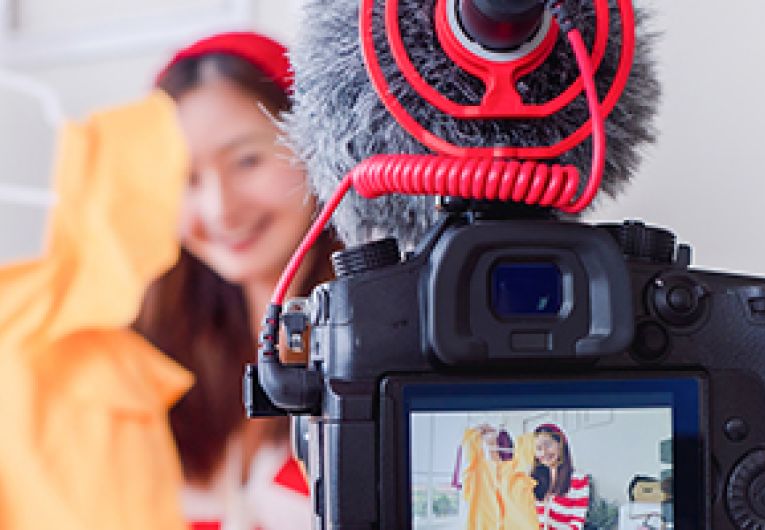
Guide to Starting a Podcast
Podcasts are quickly becoming one of the most popular ways people consume content. FastCompany reports that Apple has over 525,000 shows available now. While early podcasts were launched as entertainment programs, businesses are starting to make them a part of their digital marketing strategy. That’s because 15 percent of Americans listen to at least one podcast each month. That’s over 39 million people.
Podcasts are an emerging opportunity for businesses to connect with customers and tell their story. They offer a number of benefits to small businesses including:
- Repeated reach – Since listeners “subscribe” to podcasts, businesses have the ability to reach the same audience numerous times with each new episode. And subscribers can share it with their contacts, extending the reach even further.
- Building relationships – Podcast listeners feel like you’re talking directly to them. Over time, they get more familiar with your business and develop a sense of trust.
- Highly effective and engaging – A study of 300,000 podcast listeners found that 63 percent bought something a host presented on the show.
Thinking about starting a podcast for your small business? This eGuide will help you learn what it takes to create a professional-sounding podcast and measure its success.
What Is a Podcast?
A podcast is an episodic series of digital audio files that a user can download and listen to. They are often available on a subscription basis, so new episodes can be automatically downloaded to an individual’s mobile device or computer. Subscribers are then free to listen to the podcast on their own schedule.
What Equipment/Services Are Needed?
The cost for starting a podcast will depend on the equipment and services you use to create it. Generally, you will achieve higher quality with higher-end equipment, but you can start small and invest in better equipment as you go.
The basic elements are:
- Microphone – These are available in analog and digital formats. Here are Lifehacker.com’s recommendation for the five best desktop microphones. They range in price between $40 and $200. Some connect to your computer through a USB and others operate wirelessly. If you use an analog mic, you will need to purchase additional equipment to connect to your computer. Consider purchasing a pop filter (or make one). It will reduce popping noises you get from saying words with plosive sounds like the letter “p.”
- Computer with editing software – Use your computer to record, edit and upload your podcast. Be sure your computer has the right ports to connect to your microphone. You will also need audio editing software. You can get free, open source software such as Audacity, or purchase commercial software for less than $100. Part of the editing process might include adding background or theme music from sources like the Free Music Archive.
- Hosting site – You can store podcasts on your website, but that can negatively impact its overall performance. Check with your website professional for recommendations. Another option is to use a hosting service. This Huffpost blog article reviews the pros, cons and costs for three popular hosts. From the hosting site, you can upload the podcast to sites like iTunes Connect where it can be accessed by the general public.
What Should I Podcast About?
Businesses are using podcasts to share useful content on a number of topics, just as they do with social media posts. But the addition of audio adds an even higher level of engagement with potential customers.
Just like social media marketing, podcasts require a commitment. You will want to have a specific audience in mind and generate an editorial plan that outlines the topics you’ll cover when starting a podcast. Consider how often you will publish a new podcast and on what schedule. That will set an expectation for listeners and keep them coming back for more episodes.
The content of each podcast will be driven by your objective. Do you want to promote a new product or service? Build your reputation as an industry expert? Connect with your local community? Share content?
This article from Medium provides case studies and podcast ideas for each of these goals.
How Do You Measure Success?
Creating a podcast can be a fun way to get your message out. But the project isn’t complete until you measure the results. The Come Alive Creative team suggests using these metrics to determine if you’re getting a return on your podcast investment:
- Number of listeners/downloads – This is an easy metric to obtain from your publishing site, but be careful about interpreting the numbers. It’s not about how many are listening, but how many from your target market like your podcast.
- Podcast reviews – Sites like iTunes allow listeners to rate your podcast. High ratings can indicate that you hit the mark.
- Website/email stats – Take a look at your website and email metrics before and after a podcast is launched. Are you getting more traffic? Are your open rates higher? Are you getting greater conversions? Are more people signing up for your newsletter? Podcasts may be a contributing factor to these stats.
Starting a podcast can be an effective way to connect with existing customers or build new audiences. This eGuide will help you get started with the basics. For more information and a detailed step-by-step guide, check out this resource from Lifehacker.com.
The trends, insights, and solutions you need to grow your business.
By signing up, you’re subscribing to our monthly email newsletter, The
Wire. You may unsubscribe at any time.
Your information stays safe with us. Learn more about our privacy policy.











